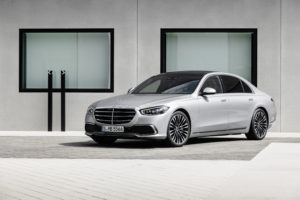
2021 Mercedes S-Class up to 132 lbs. lighter, more than 50% aluminum
By onAnnouncements | Business Practices | Market Trends | Repair Operations | Technology
Mercedes on Wednesday announced the “bodyshell” of the next-generation 2021 S-Class would present repairers with a mixed-material structure that leans aluminum but still carries a significant amount of steel.
“The newly developed aluminum/steel hybrid bodyshell increases the aluminum content to more than 50 percent by weight,” Mercedes wrote of the sedan. “The high proportion of aluminum is achieved by using cast and extruded structural components. This form of lightweight design and construction requires highly complex joining techniques. It demonstrates the expertise of Mercedes-Benz in the luxury sedan segment, as well as the quality arising from close, yet barely perceptible body joints and the precise fit of the design surfaces.”
Mercedes said it built the S-Class body-in-white “with a particular focus on lightweight construction,” and the car could weigh up to 132 pounds less than the 2020 model.
Single-piece “side wall panels” are aluminum. “Particular importance was given to achieving close joints and high-quality radiuses,” Mercedes wrote. The roof, hood, fenders, trunk lid, doors are all sheet aluminum, and the “side members” in the sides, front and rear are extruded aluminum, according to Mercedes.
Things get more complicated as we move inward.
“The extremely stable side wall structure comprises the pillars, the side roof frame and the side members,” Mercedes wrote. “The material mix of aluminum and high-strength steel alloys helps to reconcile the conflicting aims of lightweight design and crash resistance. The inner shells are partly made up of several components, with particularly large areas for the nodal points between the pillars, roof frame and side members according to the potential loads.”
Mercedes said the safety cage combines hot-formed high-strength steel crossmembers in the firewall and rear. “At the sides this is complemented with extremely rigid side sills of extruded aluminum sections, which are larger than in the preceding model, with four internal chambers,” Mercedes wrote.
The floor uses both ultra-high-strength steel and press-hardened steel, for Mercedes said it intends the energy in “all impact scenarios” to travel into the floor.
“The robust center tunnel and the lateral side members provide the basis for this,” the OEM wrote. “These assemblies are connected using further cross-members and diagonal struts. The design of this support structure makes the use of lighter floor panels possible. These make a major contribution to weight efficiency. The load resistance of the tunnel, which is especially important for frontal impacts, is achieved using connected sections of high-strength steel. The wall thicknesses varies according to expected loads.”
Repairers are also going to notice a change in the structure of S-Classes sporting a panoramic sunroof. Mercedes said it moved diagonal rear struts from the diffuser airflow to above the exhaust for aerodynamic purposes.
Mercedes said the front of the S-Class includes a ring-shaped upper structure, side members, and the “integral carrier” supporting the lower suspension arms, steering and engine.
“Additional polymer connecting elements between the crash levels ensure particularly effective energy absorption in the early phase of a crash,” Mercedes wrote.
The front of the structure manages energy in an interesting bit of choreography that collision repairers will have to preserve.
In a frontal collision, the integral carrier directs longitudinal force into the floor via a “special crash support system.”
“In the case of semi-overlapping collisions, the cross-connections in the front section are able to activate the side unaffected by the impact, i.e. the right side of the structure in case of a semi-overlapping collision on the left, and vice versa,” Mercedes wrote.
“In cases of increased impact, the wheels are supported against the rigid side wall and the wheel impact element positioned ahead of it. The geometry and strength of the side sills are configured accordingly.”
Mercedes said it also placed a high-strength steel crossmember between the A-pillars to bolster the firewall.
The OEM didn’t just look out for its own customers. Mercedes said “compatibility with other road users was an important development objective” too.
“(A)s an addition to the previous concept, the front flexural member is designed to provide increased stability and a broad impact surface for the other vehicle in an accident.”
Mercedes designed the back of the S-Class in a two-zone fashion to address it getting rear-ended. Cast aluminum allows the fuel tank housing to stay “almost deformation-free,” Mercedes said.
“… The purpose of the crumple zone behind this is mainly to dissipate impact energy with the help of extruded aluminum structures,” Mercedes wrote.
The rear of the vehicle also handles semi-overlap crashes similar to the front of the S-Class; “the rear flexural member directs the loads into the side unaffected by the impact, so that both side member paths can be activated,” Mercedes wrote.
Mercedes revealed active safety countermeasures ahead of the S-Class’ official debut, including an optional rear airbag and an optional E-ACTIVE BODY CONTROL suspension package that can also hike up the car to mitigate side impacts. Read more about those here.
More information:
“The new Mercedes-Benz S-Class”
Mercedes, Sept. 2, 2020
Mercedes OEM repair procedures
Images:
A 2021 Mercedes S-Class is shown. (Provided by Mercedes)
Repairers are also going to notice a change in the structure of 2021 Mercedes S-Classes sporting a panoramic sunroof. Mercedes said it moved diagonal rear struts from the diffuser airflow to above the exhaust for aerodynamic purposes. (Provided by Mercedes)


